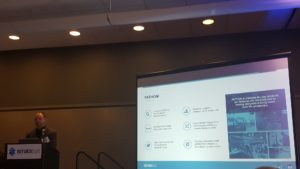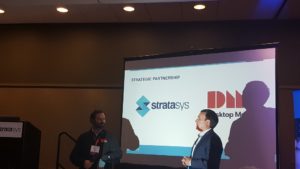 Advanced manufacturer FATHOM, based in California, has had a busy year so far: the company expanded its on-site managed services, showcased a video game controller at SOLIDWORKS World that was 3D printed using a Stratasys F123, demonstrated a DragonFly 2020 3D printer at CES with partner Nano Dimension, and at RAPID + TCT last week, Stratasys announced that FATHOM is among the earliest customers working with its brand new Continuous Build 3D Demonstrator Technology. Right before the event, Stratasys also extended its partnership with Desktop Metal; today, we learned that FATHOM has also partnered with the busy new metal 3D printing company.
Advanced manufacturer FATHOM, based in California, has had a busy year so far: the company expanded its on-site managed services, showcased a video game controller at SOLIDWORKS World that was 3D printed using a Stratasys F123, demonstrated a DragonFly 2020 3D printer at CES with partner Nano Dimension, and at RAPID + TCT last week, Stratasys announced that FATHOM is among the earliest customers working with its brand new Continuous Build 3D Demonstrator Technology. Right before the event, Stratasys also extended its partnership with Desktop Metal; today, we learned that FATHOM has also partnered with the busy new metal 3D printing company.
- [Photos: Sarah Goehrke]
“It is really exciting to partner with Desktop Metal because we get the opportunity to connect a broader engineering and manufacturing market with a lower barrier-of-entry solution for metal additive technologies. What is possible with current metal 3D printing equipment is exciting but it is still cost prohibitive so the adoption of metal 3D printing is slow,” FATHOM’s Advanced Technology Manager Michael Duncan told 3DPrint.com. “We know that the market is more than ready for a system that is both office friendly and economically accessible. Now, more design and engineering teams will have the opportunity to explore what’s possible with metal 3D printing and many new application innovations will develop at a much faster rate.”
![]() FATHOM announced that it signed a partner agreement with Massachusetts-based Desktop Metal, which got its start in 2015 and is committed to making metal 3D printing accessible to engineers and manufacturers around the world. Desktop Metal is everywhere these days: following its major presence at RAPID + TCT last week, 3DPrint.com saw one of its resellers at the Science in the Age of Experience event in Chicago this week.
FATHOM announced that it signed a partner agreement with Massachusetts-based Desktop Metal, which got its start in 2015 and is committed to making metal 3D printing accessible to engineers and manufacturers around the world. Desktop Metal is everywhere these days: following its major presence at RAPID + TCT last week, 3DPrint.com saw one of its resellers at the Science in the Age of Experience event in Chicago this week.
Ric Fulop, CEO and Co-Founder of Desktop Metal, said, “We are excited to be partnering with FATHOM both as a manufacturing service center and a sales partner as we look to broaden the adoption of our metal 3D printing systems. Rich Stump and Michelle Mihevc have built an incredible team who will be integral in expanding market opportunities and driving the growth of our customer base across diverse industries.”

Desktop Metal’s Studio system was 3D printing onstage at RAPID + TCT when Ric Fulop presented in a morning session [Photo: Sarah Goehrke]
Duncan told 3DPrint.com, “The Studio System allows for metal part design and refinement in a way that is familiar to designers and engineers today. Safe and easy to use like many FDM-based systems. The Production system will enable a better Direct Digital Manufacturing (DDM) experience. Part designs can be created with unique features or assembly options without the constraints of tooling requirements such as draft, wall thickness, lightweighting, or complex internal passages normally difficult if not impossible to realize using traditional technologies. All the advantages of metal 3D printing like speed and freedom of design can now be easily realized right in your office. Now, the only limitation really is your imagination! Also, we strongly feel that there is a huge opportunity to use this technology for accelerating tooling applications, such as injection molding, jigs, and fixtures.”

Desktop Metal and Rize were represented at the Caelynx booth at Science in the Age of Experience [Photo: Sarah Goehrke]
The cloud-connected furnace combines SIC high-powered microwaves and SIC heating elements to sinter the parts once the primary binder has been removed. It uniformly heats parts to a temperature just below their melting point, and can reach up to 1400°C. Aligned with the company’s goal of making metal 3D printing easier and more accessible to users, the system has web-based software and features fast material changes and hand-removal of supports. It’s also designed for prototyping, as it can produce near-net-shape metal parts.
“Prototyping small precision parts intended for volume powder metal production processes such as Metal Injection Molding (MIM) or Pressed Metal (PM) is difficult. Developing tooling and qualifying production methods can be a long iterative process. Desktop Metal 3D printing solutions provide more competitive options than traditional tooling resulting in accelerated part development. Users can much more easily build metal parts for evaluation, functional testing, and production use. It’s also exciting how many materials will be made available. Desktop Metal is planning for a variety of options, from steels and aluminum to superalloys and titanium,” Duncan told 3DPrint.com.
 The DM Production System is scheduled for release in 2018, and has a build area of 330 x 330 x 330 mm and a breakneck speed: up to 8200 cm3/hr, which is 100 times faster than laser-based technology. It’s the fastest machine for mass producing high resolution 3D printed metal parts, and uses a proprietary Single Pass Jetting (SPJ) technology, which lowers the cost per part dramatically.
The DM Production System is scheduled for release in 2018, and has a build area of 330 x 330 x 330 mm and a breakneck speed: up to 8200 cm3/hr, which is 100 times faster than laser-based technology. It’s the fastest machine for mass producing high resolution 3D printed metal parts, and uses a proprietary Single Pass Jetting (SPJ) technology, which lowers the cost per part dramatically.
Laser-based processes weld parts to to the build plate, but the DM Production system creates parts that are surrounded by loose powder: software will arrange the parts in order to maximize the build area in all axes. This allows the full build envelope to be used, which means higher productivity per build. The technology is bi-directional, so two full-width print bars, with over 32,000 jets, work with powder spreaders to both spread powder and print in one pass over the build area. This jets millions of droplets per second, so that whenever there is movement in the printer, there is also printing.
“Current metal 3D printing technologies require support structure removal and second operations such as processing feature edges or roundness of holes, as well as removing trapped metal powder. Much of the cost, lead-time, and part accuracy result from these extra steps,” Duncan told 3DPrint.com. “I’m looking forward to the DM Production System that will be able to produce net shape parts in a variety of metals with minimal second operation process steps. There isn’t another system that can provide as much part design freedom for prototype and production metal parts that fast.”
Share your thoughts on this partnership in the FATHOM forum at 3DPB.com.
Subscribe to Our Email Newsletter
Stay up-to-date on all the latest news from the 3D printing industry and receive information and offers from third party vendors.
You May Also Like
3D Printing Financials: Fathom Struggles in Financial Quicksand During Critical Transition
Facing a year of key transitions and financial pressures, Fathom (Nasdaq: FTHM) has filed its annual report for 2023 with the U.S. Securities and Exchange Commission (SEC). The document outlines...
Latest Earnings Overview for Australian 3D Printing Firms Titomic and AML3D
Australian 3D printing manufacturing firms Titomic (ASX: TTT) and AML3D (ASX: AL3) reported their financial results for the period from July to December 2023, marking the first half of their...
3D Printing Webinar and Event Roundup: April 7, 2024
Webinars and events in the 3D printing industry are picking back up this week! Sea-Air-Space is coming to Maryland, and SAE International is sponsoring a 3D Systems webinar about 3D...
3D Printing Financials: Unpacking Farsoon and BLT’s 2023 Performance
In the Chinese 3D printing industry, two companies, Farsoon (SHA: 688433) and Bright Laser Technologies, or BLT (SHA: 688333), have recently unveiled their full-year earnings for 2023. Farsoon reported increases...



































